Abstract:: Content marketing is still the most sustainable mid- to long-term strategy to increase your site’s traffic.
Don’t you like sustainable traffic?
Whether you are operating a small- or medium-scale business online, content marketing is the fuel to drive it month after month.
When you feel your site is not fulfilling its purpose, ask yourself: are you feeding it with enough quality content?
Beefing up your website or blog with content regularly whether you update an existing post or create a new post is one way to succeed in content marketing.
So what is content marketing, and how do you effectively carry it out?
I hope this page will be helpful as you learn and implement these content marketing basics and tips.
Note: We continue to update this page as we learn new things and re-learn our workflow in content marketing.
Before going into content marketing, let us talk about the basics like what content is and why it is important.
Skip by clicking this link if you want to jump directly into content marketing.
What Is Content Marketing?
Content marketing is another type of marketing that involves curating, creating, and promoting your online material or content. Content marketing heavily depends on content strategy. These materials can be videos, blog posts, images, infographics, and social media posts. Content marketing is not direct selling. Content marketing is not intended to explicitly promote a brand. Its objective is to stimulate interest in prospects and customers on matters related to a company’s products or services. Its purpose is to offer free useful and informative content.
Content marketing involves the creation and sharing of online materials that are intended to increase your website’s traffic and ultimately grow your business. The types of content marketing materials include infographics, videos, newsletters, blog posts, and social media posts, among others.
To know more, read: What Is Content Marketing?
Types of Content Marketing
Content marketing is a very important marketing strategy that will boost your business. There are many types of content marketing you can use no matter what type and size of business you have. If you ask what is best to use for your business, well, it actually depends on many factors, including your audience, the type of information you want to share, your goals, and more.
Just to be clear, content marketing does not involve direct selling. That job is for traditional advertising. While both have a common goal, which is to turn your audience into paying customers, content marketing attracts your target audience using relevant, timely, and useful information related to your product or service offering instead of throwing a direct sales pitch.
The core of content marketing is to offer value to its prospects and customers through useful content.
Read the Types of Content Marketing.
More on this later. See content marketing process below.
The Purpose of Content Marketing
The purpose of content marketing is obviously to turn the target audience into customers or clients. (But perhaps not just one-time customers.)
Content marketing is a marketing strategy that consistently delivers content to a target audience to turn them into loyal customers. The content can come from any online material like a blog post, image, video, infographic, podcast, social media posts, etc.
The Purpose of Content Strategy
The core purpose of content strategy is to offer value to its target audience by providing what the audience is looking for (content that is useful, informative, entertaining, etc.)

Read Types of Content Marketing.
See the difference between content marketing and traditional advertising.
Read further on what content marketing is.
Back to Content Marketing Guide
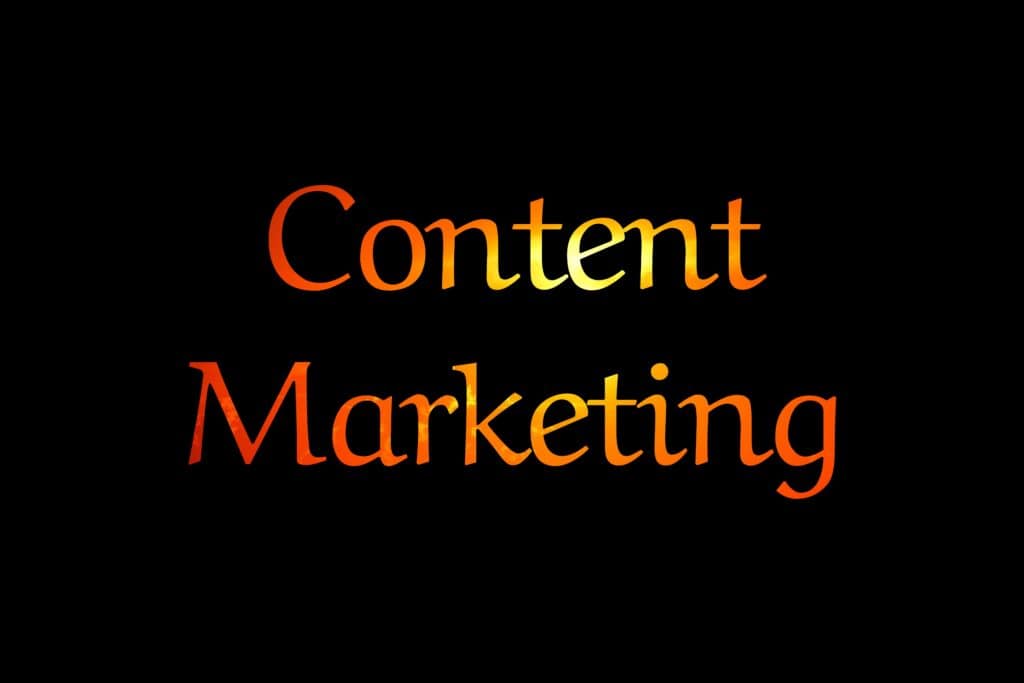
5 Reasons Why Content Marketing Is Important
Content marketing is important to help meet your company’s ultimate goal – to earn more sales and generate revenue. When effectively implemented, content marketing gives you an opportunity to:
- build good relations with your audience;
- build your brand identity;
- create trust and positive brand image;
- gain competitive advantage; and
- promote your brand and your products with a wide reach.
All these would result in increased website traffic that will favorably increase website conversions.
Read the full article: 5 Reasons Why Content Marketing is Important
6 Reasons Why Content Marketing Is Valuable Long Term
Content marketing is a mid to long-term marketing strategy that you can utilize to increase your website traffic and turn visitors into paying customers. With an effective content marketing strategy, you will reap positive results in the long run.
Content marketing does not show results easily and quickly. It takes time to build and establish, but you can enjoy its long-term benefits once you do. Read the full article to know some of the reasons why content marketing is valuable long term:: Reasons Why Content Marketing is Valuable Long Term.
How Content Marketing is Usually Done
Summary
The content marketing strategy is a cycle. It does not just follow a straight-line process but a cycle that allows you to improve your tactics and become more effective over time.
It usually involves the following process:
- Identify your content marketing goals.
- Know your target audience and their interests.
- Plan how to make your content relevant, unique, and consistent.
- Create valuable and optimized content.
- Promote content in different channels (blogs, social media, email, etc.).
- Generate and analyze reports.
- Go back to planning.
- See what can be done to improve results.
- Identify contents generating the most responses or sales so they may be amplified.
- Incorporate new ideas.
Read further on how content marketing is usually done.
The Goal of Content Marketing

Content marketing aims to engage, educate, and inspire audiences with valuable and relevant content that meets their interests and needs. Understanding the results-driven potential of content marketing is crucial for success, whether you’re a business owner, marketer, or content creator. Stay updated with the latest trends in the dynamic world of content marketing to elevate your brand and unlock your business potential.
Content marketing goals often get confused with outcomes. While outcomes like brand awareness, conversion, and customer retention are desirable, they are the results of our marketing strategies. To truly succeed, we need to shift our focus to more user-centric goals.
Instead of focusing solely on outcomes, consider these user-centric goals:
- Education: Providing valuable information to your audience.
- Inspiration: Inspiring your audience to take action or change their perspective.
- Entertainment: Engaging your audience with enjoyable content.
The primary goal of content marketing is to attract and acquire a well-defined audience and ultimately drive profitable actions. To achieve this, it’s essential to think like a content marketer and understand the opportunities around you.
Here are some content formats to consider:
- Infographics
- Web pages
- Podcasts
- Videos
- Books
Remember, the key to successful content marketing is to add value to your audience.
Key Takeaways:
- Invest in quality content: Great content often requires time or money.
- Seek customer feedback: Ask your customers what kind of content would be helpful to them.
- Act now: Many companies are still not leveraging content marketing, so seize the opportunity.
- Expect a strong ROI: Content marketing can yield significant returns when executed effectively.
How Do We Implement an Effective Content Marketing Campaign? How Are We Different?
We are not so different from many others doing content marketing.
Earlier today, a client is asking me almost the same question, and I agree with her concern.
Regardless of the channel used (FB, email, blog, etc.), content can often go to waste with no one reading it. The resources spent to curate, create, and promote the content do not come cheap.
I often try to dodge information overload whenever I open my email.
The concern is very valid; therefore, I would like to address it here, so our readers may know how we do content marketing and why we do it this way.
At least that way, our readers may know if our content marketing strategy is worth implementing.
Back to Content Marketing Guide
How are we doing content marketing?
We always start with the basics. I usually do this with the client; no one in my team can better understand my client’s business except the client himself/herself.
First, we try to identify the two items below:
Identify the Target Audience
Identify the Unique Value Proposition
Identifying the above vital points should not be done in haste. These are crucial points to think about. The amount of time you spend identifying these two key points can dictate how much money you may earn or lose in the next 3-7 months.
For a small business like mine, it is essential to know whether the content marketing strategy is working or not as soon as possible.
Decisiveness is also essential for every penny counts—more on this in Analytics.
Content marketing process
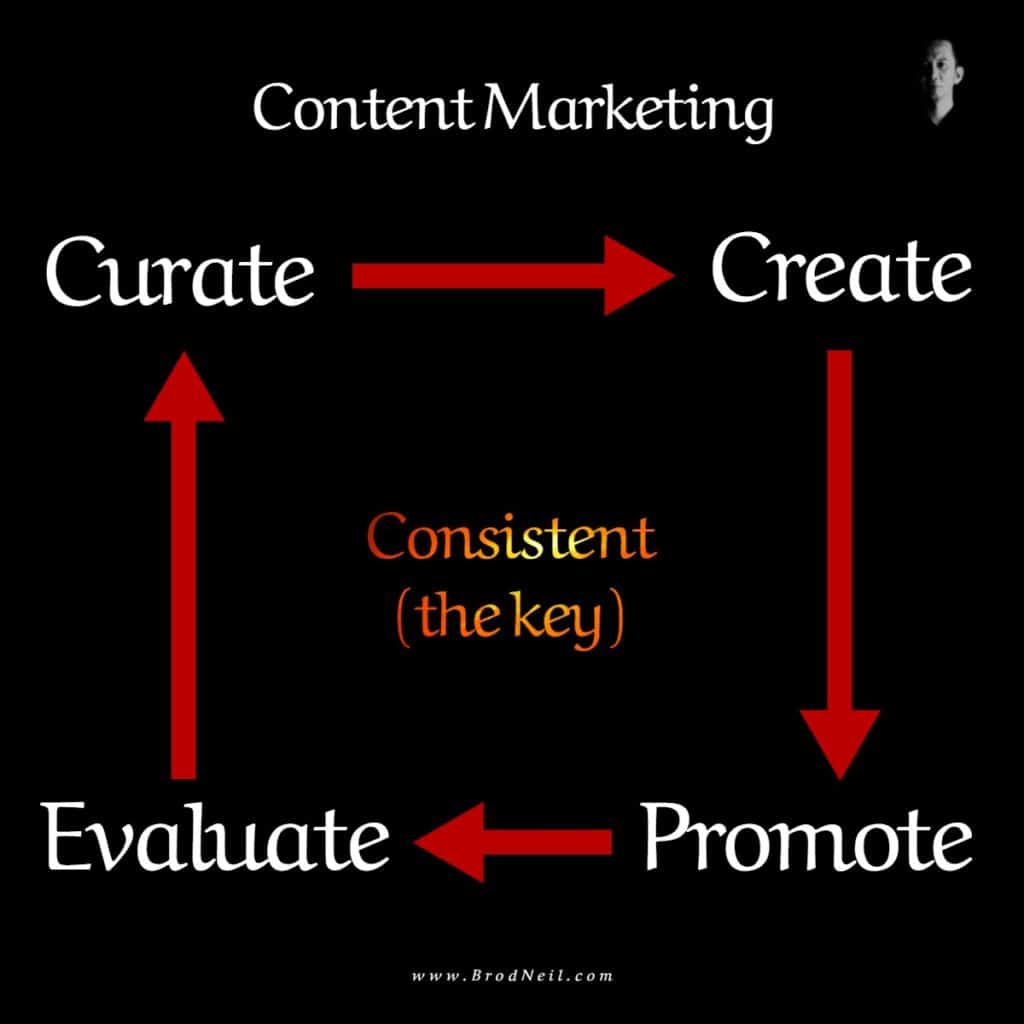
Step #1: Curate
Content Curation is the first step of the content marketing process. It is the act of finding, collecting, and organizing your digital content for a specific topic.
The word seems to be derived from the Latin word curatus (past participle of curare, which means “to take care of.”)
Whether you write something original or make something better from an existing idea or content, to a certain degree, curation is involved. (This is my take.)
Step #2: Create
Content creation is the 2nd process. It is the act of doing the following:
- Preparing or outlining your ideas based on the curated content in step #1.
- Creating the content as an article, a graphic illustration or an infographic, a video, a podcast, or any other possible format where your target audience can access your content.
Step #3: Promote
Content promotion is the 3rd step in the process. It is distributing your content to most, if not all, of the other channels your target audience is possibly consuming. This is why identifying your target audience is very important, including knowing your audience’s media consumption.
Promotion can be both paid (advertising) and organic.
In today’s digital marketing arena, I feel it is no longer enough to rely on quality content and SEO (unless perhaps your site has a very high domain authority). Nevertheless, you always want to outmatch your competition, don’t you?
Step #4: Evaluate
The last step in the content marketing process is to evaluate your campaign. That measures whether or not your content marketing strategy or effort is effective and efficient.
The purpose of reviewing your campaign is the following:
- to know whether or not the campaign’s conversion rate is acceptable (conversion is the purpose of why you are doing the campaign, be it for a lead, a subscription, a sale, a download, etc.);
- to know whether or not we truly identified and understand our target audience (Is the topic really relevant to them? Is it what they are looking for?); and finally,
- to decide whether to stop or continue the campaign (that is to continue as it is or to refine the campaign).
Be consistent
This is not part of the steps in the process, but this is surely a key factor in content marketing.
Be consistent.
Content marketing is both a marathon and a sprint. Yes, I agree that you have to be quick in deciding and refining your strategy and workflow; yet ultimately, your perseverance matters most.
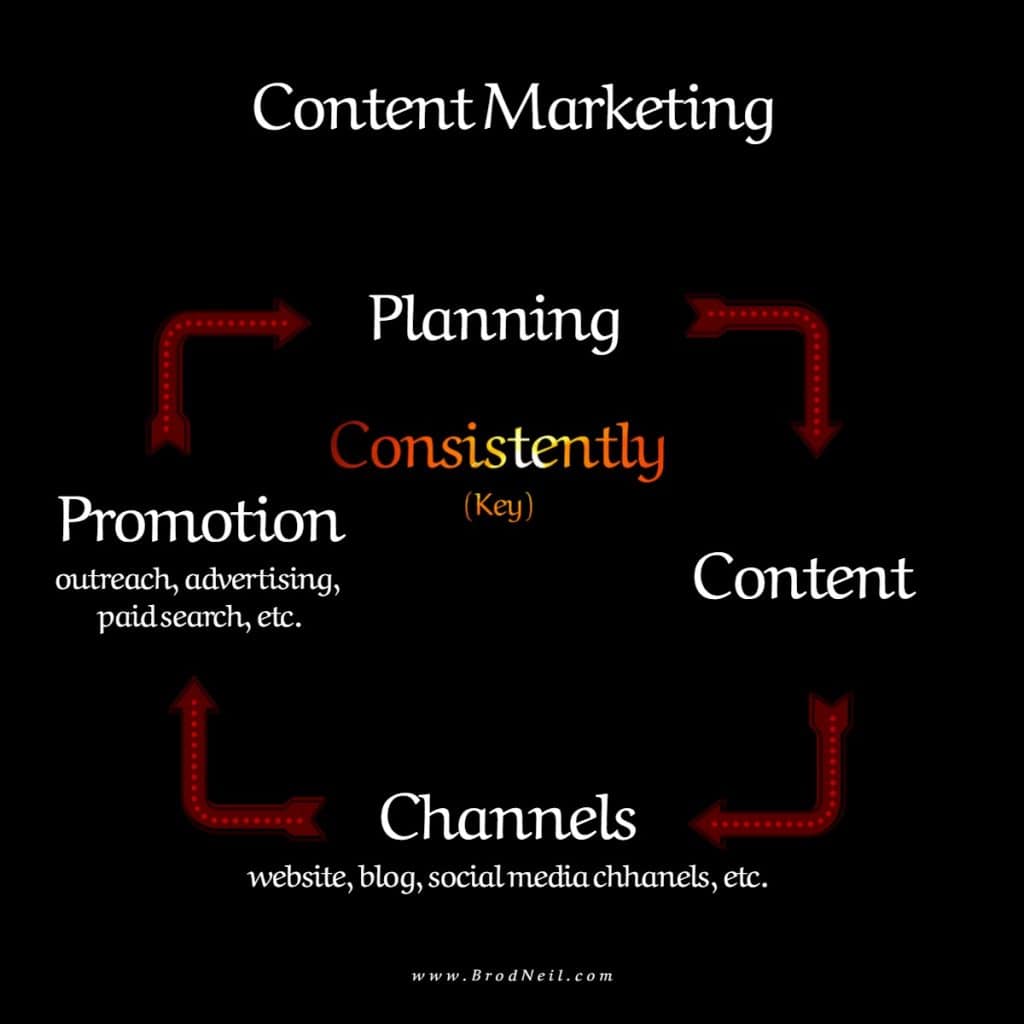
Back to Content Marketing Guide
AIDA model
AIDA is an acronym for Attention or Awareness, Interest, Desire, and Action. It is a classic model that is widely used in marketing and advertising. It describes the stages that occur from the time when a consumer (target audience) becomes aware of a product, service, or brand to when the consumer (target audience) makes a purchase decision (or becomes a customer).

Back to Content Marketing Guide
Sales funnel
Another concept to understand in digital marketing is the sales funnel. There are many different illustrations of a sales funnel. Yet, ultimately, like the AIDA model, it boils down to the process of understanding the target audience, prospect, or customer from awareness to purchase (and possibly to a loyal customer).
The image below is how we’d like to illustrate it based on the content marketing process that we are doing.
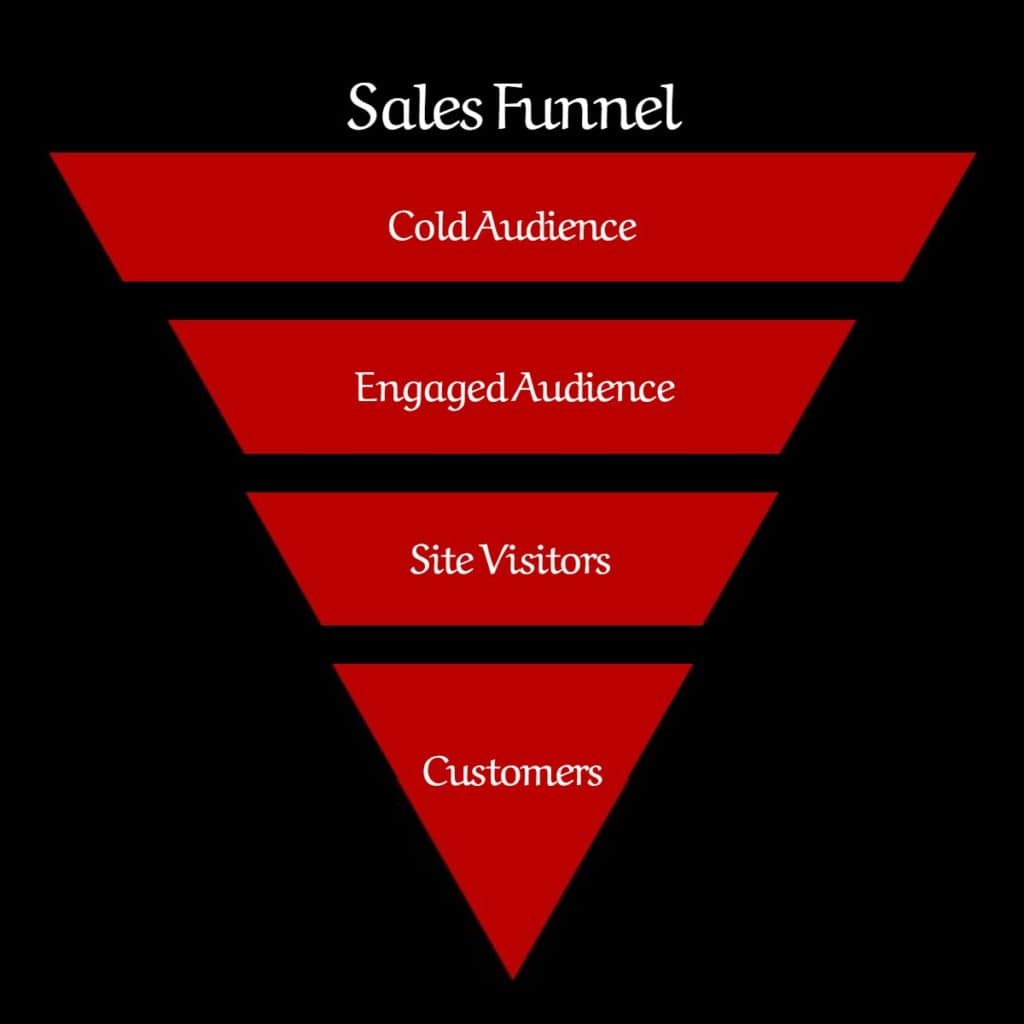
We can also compare the AIDA model with the sales funnel illustration to understand how our target audience reacts or responds to our content marketing efforts.
Below, you can see that every time we complete a content marketing process, it goes to a different stage of the funnel.
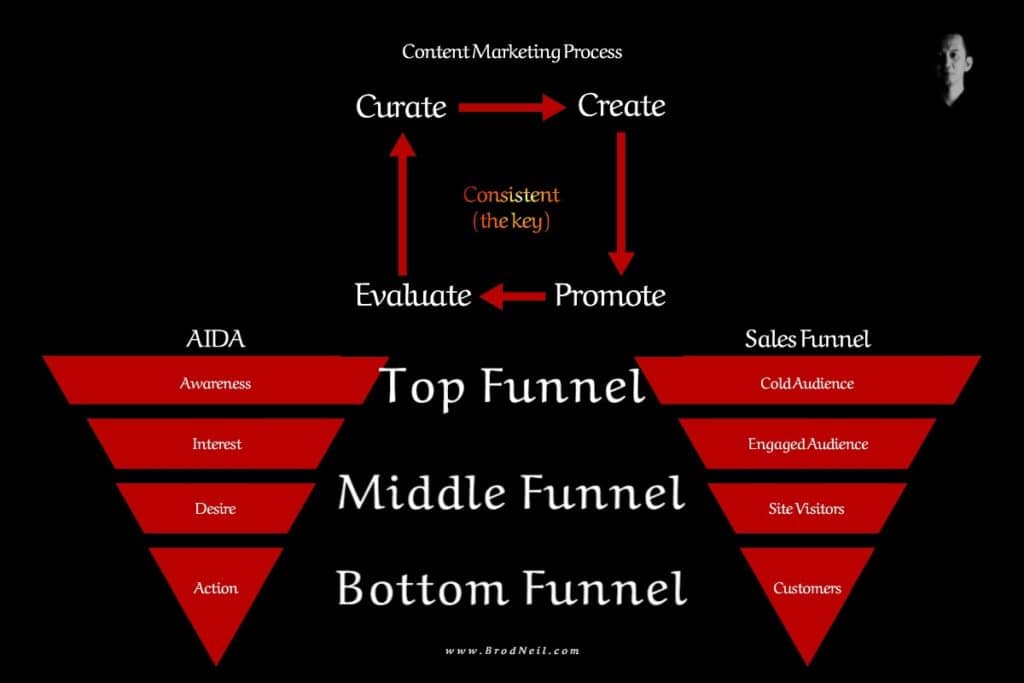
Awareness = Top Funnel = Cold Audience
Granting everything is perfect (for the sake of illustration), let us take, for example, Facebook advertising. The first round of promotion goes to our target audience who has not known us yet. Those who have not visited our Facebook page, those who have not engaged or liked our posts, and those who have not visited our site (website, blog, etc.). Let us say because of this promotion, Juan, who opened his Facebook account, became aware of our service, product, and brand. Juan, at this point, is at the top funnel. He is still a cold audience, though he is already aware of our product, service, or brand.
Juan then decides to engage and click the like button on our post. This time, he is somewhere transitioning from the top funnel to the middle funnel. By clicking, we know Juan perhaps has an interest in our topic. He is now an engaged audience. In this example, he is now one of our FB page audience.
The next type of content is geared toward those who have engaged with our FB posts or those who have liked our page. In short, those who have shown interest in our topic, like Juan. We aim for Juan to visit our site (or blog, for example). If he becomes a site visitor, we can say that Juan now wants to consume more of our topic, info, product, service, or brand. This is still the middle funnel.
The last promotion is created for the bottom funnel. That is to turn our target audience and prospects into customers. At this stage of the promotion, we are hoping that Juan will take action and become a customer.
It does not stop here; the process continues to keep Juan as a delighted loyal customer.
Back to Content Marketing Guide
Why Are We Doing Content Marketing This Way?
This is our mission-vision in content marketing
Mission:
To implement an applicable, practical, and effective content marketing campaign, use a tried-and-tested system that can give us the environment we need to implement creativity and customization.
Vision:
To free up our clients’ time doing content marketing so they can focus on the nature of their business while we take care of most of the planning, implementation, and monitoring.
To use as an updated guide for our team when we implement content marketing to our sites.
To offer our readers a comprehensive applicable, practical, and effective content marketing plan or strategy for them to follow and execute.
I like to coin it as PEACE content marketing:
Back to Content Marketing Guide
The PEACE criteria in content marketing.
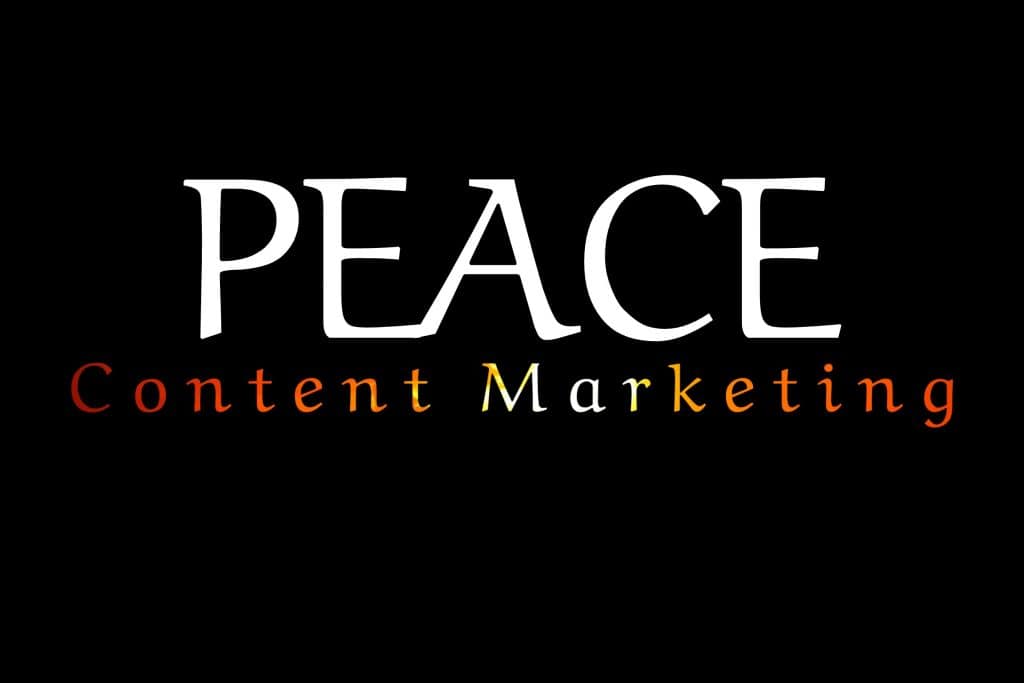
Practical = doable or feasible to do, rather than a theory or an idea.
Effective = Adequate to accomplish a purpose or a goal.
Applicable = relevant or appropriate in the context it’s being used.
Consistent = act or do in the same way over a period of time.
Efficient = spend the least time doing something for maximum productivity.
Effective means that it can be measured.
PEACE Content Marketing
The PEACE criteria in content marketing.

Practical = doable or feasible to do, rather than a theory or an idea.
Effective = Adequate to accomplish a purpose or a goal.
Applicable = relevant or appropriate in the context it’s being used.
Consistent = act or do in the same way over a period of time.
Efficient = spend the least time doing something for maximum productivity.
Effective means that it can be measured. See Analytics.
Get our PEACE Content Marketing Infographic
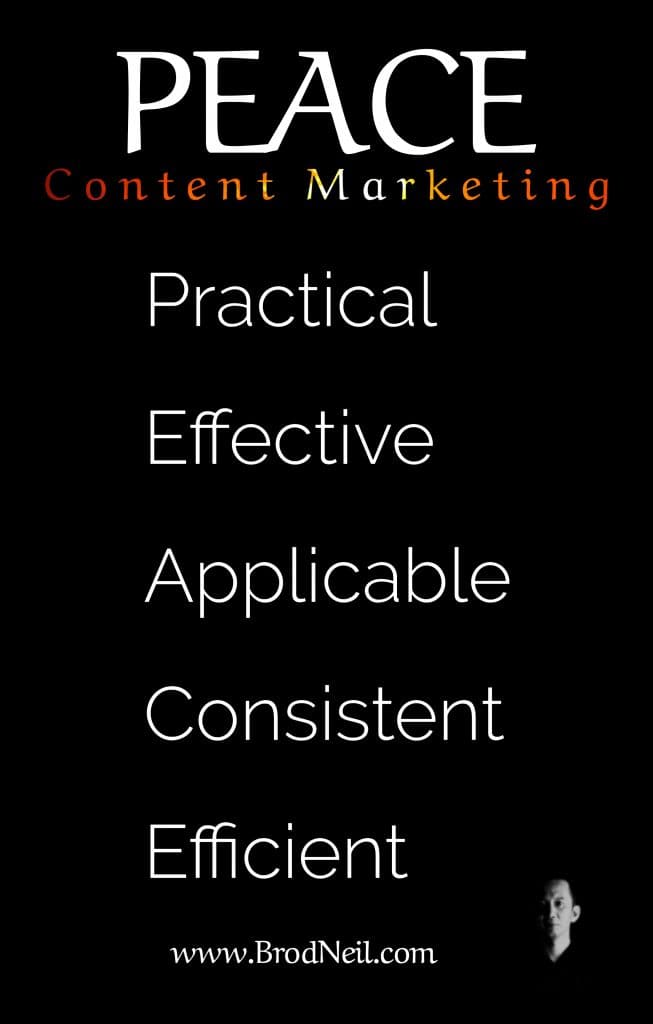
Copy-paste the code below:
<a href="https://www.brodneil.com/peace-content-marketing/"><img src="https://www.brodneil.com/wp-content/uploads/2020/05/PEACE-Content-Marketing-Infographic.jpg"></a>Back to Content Marketing Guide
How to Measure Content Marketing Success 101
Measuring content marketing success is crucial for marketers and businesses to determine the effectiveness of their marketing investments. It tracks return on investments (ROIs) and ensures alignment with core objectives, indicating the value and efficiency of marketing efforts.
Read: How to Measure Content Marketing Success 101
More on What We Do in Content Marketing
Tried-and-tested system
Making use of a tried-and-tested system is a smart move. Why create one when there are others who have already done them efficiently and effectively?
A tried-and-tested system can make you consistent in your implementation. Content marketing is not a sprint. It is a marathon.
Being consistent is the key factor. A tried-and-tested system is what you need to be consistent.
We use ResultFlow for the following reasons:
- It is effective and battle-tested by many small-to-medium scale businesses located in different parts of the globe.;
- It is efficient to spend the least time for maximum productivity;
- I can customize its use in line with the content strategy we have in mind for a particular client or business (the default setting is already very optimal anyway);
- It is way above the charts when it comes to our PEACE criteria.
- It is offered to a small group (I believe that they are now trying to open up to the public now); and
- I don’t have the resources to build this system. (I feel very fortunate to take part in their community.)
Back to Content Marketing Guide
Creativity and customization
Recap
Apart from those mentioned:
- PEACE criteria
- Tried-and-tested system
- Creativity and Customization
What makes us different may not be much.
Yet if given a chance, we do content marketing for your business as if it is our business.
We value integrity more than money: our work ethics, our expertise, our honesty and transparency, and most of all, our relationship with our clients.
Back to Content Marketing Guide
Integrity: client-provider relationship
We are a very small team, and perhaps I want to keep it this way for the following reasons:
- I don’t have many resources to go BIG;
- Small business is easier to manage; this can mean fewer headaches;
- Small business can also be more profitable in terms of percentage as it has fewer overhead expenses, and lastly,
- I can spend more time with my wife and six children.
Back to Content Marketing Guide
The Importance of Analytics
Weigh, consider, and decide quickly and effectively.
Analytics is not for viewing purposes only. It begs you to take action based on the results. It begs you to be decisive.
Back to Content Marketing Guide
Preparations Are Needed
As you begin with content marketing, there are preparations you need to make and the tools you need to set up that will make your implementation more efficient and effective. These include, but are not limited to, the following tools:
- List of topics and their keyword research
- Content management system (CMS)
- Online collaboration platforms and cloud storage like Trello, Google Drive, Teamwork, Slack, etc.
- Setting up the different social media accounts.
- Setting up the email marketing tool or software
- Writing tools like Grammarly
- Content Calendar
- Setting up your social media sharing tools like dlvr.it, Hootsuite, Buffer, etc.
- Setting up your advertising networks like Facebook advertising and Google Ads.
Back to Content Marketing Guide
Deliverables: What to Expect
- Publish and promote at least 12 abstracts a month (short substantial posts);
- Publish and promote three featured posts a month; and
- Update and promote 1 MEGA page every month.
Back to Content Marketing Guide
Keypoints when making great content
Content is the essence of your content marketing strategy. It is the voice of your business.
How can your voice be heard in a digital world flooded with content?
Whether you are making a blog post, a video, a podcast, or other types of content, here are some tips for you to begin making great content:
- Research and do it well.
- Focus on one message.
- Use keywords appropriately.
- Create an interesting and fitting headline.
- Keep your readers/listeners hooked.
- Think of your audience always!
- Keep your content aligned with your goals and your brand identity.
- Make a call to action (CTA).
- Utilize the best SEO practices in making effective content.
- Review and edit your work.
- Have someone review your work.
Back to Content Marketing Guide
Posting frequency
If you do not post content regularly, your audience may not notice you. Posting too often may also cause them to lose interest in you. How frequently should you post to maintain visibility and keep your audience interested?
Blog
As you are just beginning, you can start with one blog post per week and can move forward with 2-3 blog posts per week or even more. Studies have shown that more posts result in more website traffic. However, it is also important to consider that quality should come first before quantity.
We aim to publish one post per day.
Social media
While there are no fixed standards regarding the frequency of social media posts, my advice is to understand your target audience first. Make your best logical guess. Then test the waters and evaluate. Refind as you move along.
Share or promote at least one post per day during the best time your target audience can be most active in any or all of the following:
- TikTok
- YouTube
Back to Content Marketing Guide
Schedule and timing
Good news! You do not really have to log in and post on your blog several times a day, week, or month to post your content. Blog and social media posts may be scheduled, and several tools and apps can do this for you.
A helpful tip in scheduling and timing your posts would be to learn about the behavior of your target audience. You need to know when they are most active on social media platforms.
Are you a one-person marketing team?
Tips for a one-man content marketing team
Tip 1: Develop a Clear Strategy
Begin by aligning with executive stakeholders and developing a clear content marketing strategy. This includes defining your goals, target audience, key messages, and desired outcomes. A well-defined strategy will guide your content creation efforts and help you stay focused.
Tip 2: Build an Engaging Website
Establishing a professional online presence is crucial for any content marketing team. Create a user-friendly website that reflects your brand identity and showcases your expertise. Optimize it for search engines to increase organic traffic and ensure it provides visitors value.
Tip 3: Identify Ideal Social Media Platforms
Instead of spreading yourself thin across all social media platforms, focus on identifying the ones where your target audience is most active and engaged. Direct your resources toward creating high-quality content tailored to those platforms, whether informative blog posts, eye-catching visuals, or engaging videos.
Tip 4: Plan Ahead with a Content Calendar
Organize your content creation process by creating a multichannel content calendar. This will help you plan ahead, maintain consistency, and avoid last-minute scrambles. Use tools like editorial calendars or project management software to schedule topics, assign deadlines, and track progress.
Tip 5: Master Time Management
As a one-person team, time management is crucial for productivity and efficiency. Prioritize tasks based on importance and urgency to ensure you’re working on the most critical projects first. Utilize productivity techniques such as time-blocking or the Pomodoro Technique to stay focused on tasks without getting overwhelmed.
Tip 6: Hire a Professional Editor
While managing all aspects of content creation, don’t overlook the importance of polished, error-free content. Finding and hiring a professional editor can significantly elevate the quality of your work, ensuring that your messaging is clear, engaging, and free of grammatical errors. An editor can also help refine the tone and style of your content to better resonate with your target audience. This investment not only improves the readability of your content but also enhances its professionalism, which can significantly impact audience perception and engagement. Look for editing services that align with your content goals and can provide tailored feedback to suit your brand’s voice.
By implementing these improved tips, you’ll be better equipped to manage every aspect of your one-man content marketing team effectively while maximizing results and driving engagement with your target audience.
You can also read about a subtopic here: Content: Best Practices and Trends.
Easy B2B Content Marketing Guide for Beginners
If you are new to the business world or in digital marketing, it can be overwhelming to learn about B2B content marketing. That is why in this guide, we try to make it as simple yet as helpful as possible for beginners like you.
Read: Easy B2B Content Marketing Guide for Beginners
Content Marketing Is a Strategic Marketing Approach
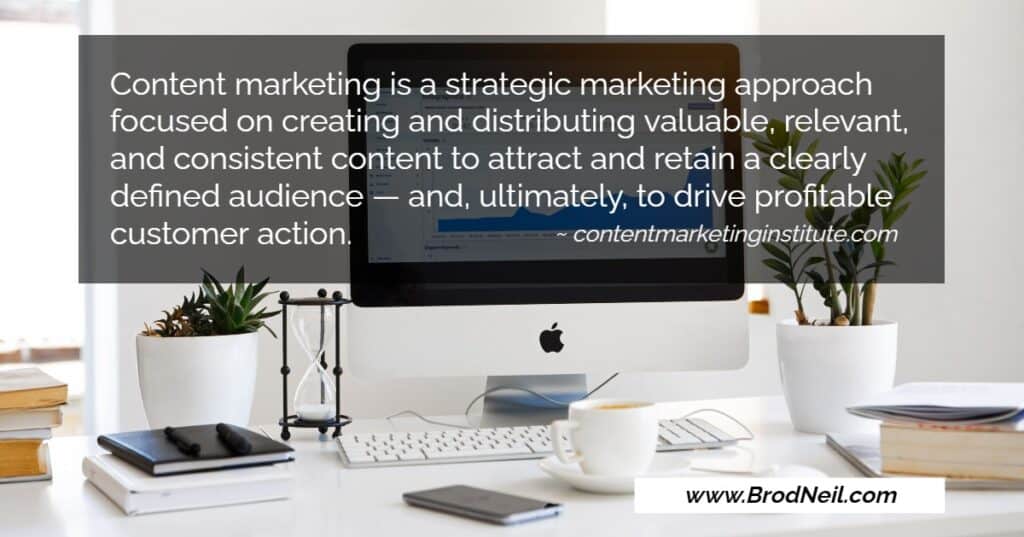
Content marketing is a strategic marketing approach focused on creating and distributing valuable, relevant, and consistent content to attract and retain a clearly defined audience — and, ultimately, to drive profitable customer action.
~ contentmarketinginstitute.com
Yes, content marketing is a strategic marketing approach that involves creating and distributing valuable, relevant, and consistent content to attract and engage a target audience. The goal of content marketing is to build trust with the audience by providing them with useful information and insights, and ultimately to drive profitable customer action.
Content marketing can be used to achieve a range of marketing objectives, such as increasing brand awareness, generating leads, building brand loyalty, and driving sales. By creating content that is tailored to the needs and interests of the target audience, businesses can establish themselves as thought leaders in their industry and build strong relationships with their customers.
Content marketing requires a strategic approach because it involves understanding the needs and interests of the target audience, identifying the types of content that will resonate with them, and developing a plan to create and distribute that content effectively. It also requires ongoing measurement and optimization to ensure that the content is resonating with the audience and driving the desired results.
Overall, content marketing can be a highly effective way to build a strong brand and drive customer action, but it requires a strategic and consistent approach to be successful.
5 Content Marketer’s Must-Have Qualities
Content marketing involves an endless cycle of curation, creation, promotion, and evaluation. The main purpose of content marketing is in its name itself—to market content in a way that attracts, develops, and encourages engagements to a specific audience. Every content marketer aims to reach more and more people—turn them from possible buyers, to subscribers, to customers, and to lifetime partners.
With over 90% of marketers using it for acquisition and engagement, it’s no question how the competition for this has definitely become tougher over time. Every day, thousands of content is being set out before the eyes of the public in various channels.
That’s a lot to take in for any ordinary marketer.
But it takes a good marketer to know that it’s not always about the numbers. Quality must always prevail over quantity.
Value-Driven

First and foremost, a good content marketer should be value-driven. To be value-driven means to have your every content anchored towards your brand’s goals and core values. Also, it calls for you to think deeply instead of dreaming high. It requires you to strive harder and pushes you to produce quality content that can actually compete against all the rest.
Being a value-driven marketer allows you to connect and empathize with your audience. In this manner, you get to understand and deliver their needs better.
To do this, ask yourself these questions from time to time:
- Is this content in line with my brand’s values?
- Does this content help and/or benefit my target audience?
- Is this content inspiring or insignificant?
- Does this content encourage positive change?
- Is this content interesting enough to be shared?
Creative

As mentioned, there are thousands of content marketers out there with the same goal and purpose as you. With this, strategizing on ways to make yourself stand out is only but necessary. While you’re at it, remember to widen your imagination.
Don’t just aim to produce a lot of content, aim to be of value.
Explore the different mediums and channels around you. Note that producing content is endless in the sense that you’re free.
Tap on your creativity and let all the possibilities run wild. Don’t limit yourself to the idea of having to do everything alone and/or traditionally.
For example, instead of focusing on traditional marketing through words alone, experiment on visuals. Research suggests that people are most likely to click on posts with visual representations—photos, videos, typographies, infographics, and etc.—not to mention how easy they are to process and understand. Moreover, you can also try tapping on influencers and producing fun quality content that works for both ends.
Again, it all boils down to you and how you make use of your innate creativity.
Back to table of contentsGenuine/Storyteller

Another must-have quality for a good content marketer is to be a good storyteller. It is our human nature to naturally love hearing stories and learning from other people’s experiences. Thus, storytelling plays a great factor to connecting to your audience and walking them through your brand smoothly.
Remember to keep it natural.
A good content is not an advertisment.
A good content marketer knows how to position and promote themselves in a way that isn’t too forceful but rather, in a manner that’s trustworthy, filled with empathy, and is genuine.
Again, don’t forget to tap on others too, especially on topics that require more knowledge and specifications. Your audience would definitely appreciate getting more resources.
Back to table of contentsOrganized/Specific

With great competition comes more content. More content means bigger room for mistakes. And all these lead to the great need for proper organization.
Another must-have quality for content marketers is to be highly organized. This means that you have to maintain an editorial calendar, create schedules, set deadlines, monitor trends and competitions, and follow the right steps for content creation.
You must learn to strategize before jumping on anything and be decisive at all times. Avoid beating around bushes.
Back to table of contentsAnalytical

The most successful content marketers know that content production is not a one-way trip. It doesn’t just stop the moment you publish a content. Rather, it is a continuous cycle of measuring and analyzing the numbers—determining what content is popular, engaging, and effective.
You have to take advantage of the different metrics and tools available and make use of them to know what sells and what doesn’t. You have to know which data to track and to use to help drive more traffic to your business.
Back to table of contentsPersistent

Ultimately, every successful content marketer needs persistence. Obviously, content marketing in itself is nothing close to easy, especially with all the pressure it comes with. But, finding success in it is not impossible at all.
The common problem for most marketers is that they expect success too soon without realizing that all good things take time. Often, they result in producing half-baked content all for the sake of having to post something. Don’t be like them. Sure, in business, time is gold. But remember that time can not and should not replace the value of quality.
You must stay positive and maintain a tight grip on your ultimate target no matter what. Don’t hang on it loose just because of the distractions around like poor performance rates, lack of engagements, slow traffic, and etc. Instead of dwelling on them too much, use those feedback to your advantage. Know that every response is necessary for your growth—good or bad. Determine where you went wrong and how you can improve.
Back to table of contentsInstead of asking, “Which content marketer am I?” ask yourself, “Which content marketer am I not?”
Sources:
- https://neilpatel.com/blog/content-marketer-attributes/
- https://copyblogger.com/what-is-a-content-marketer/
- https://contentmarketinginstitute.com/wp-content/uploads/2015/09/2016_B2B_Report_Final.pdf
7 Tips in Using Content Marketing for a Successful Product Launch
Content Marketing is the way to go these days. Most marketers have shifted from traditional marketing techniques to Content Marketing, which is more effective and cost-friendly. Statistics show that Content Marketing methods convert six times more than other marketing methods and are 62% less cost. Neil Patel, a famous entrepreneur and bestselling author shared that a site with compelling and valuable content experiences 7.8 times more site traffic than competitors. Aside from these benefits, quality content produces brand recall and customer engagement.
While content marketing primarily attracts, engages, and retains an audience for your business, you can also use this marketing strategy for other purposes. For example, you can create content ideas for virtual events.
While creating content for your content marketing strategy, take assistance from an online article rewriter. This will help you to rewrite your previous content and make it more engaging to attract the audience of your business.
Content creation is also part of different forms of marketing, such as SEO, Social Media Marketing, Public Relations, and PPC. You may also explore using Content Marketing for a successful product launch. Many brands from different industries have tried this, and it has proven effective.

Here are some tips for applying Content Marketing to have a successful product launch.
1. Use visual content as teasers on social media.
Pictures, as they say, paint a thousand words. You may harness the power of images as a teaser ad in Instagram Shop and on other social media sites. Maximize the broad reach of social media- that’s 3.78 billion people worldwide this 2021.
Visual content can help you entertain your audience and be curious about your new product. Be creative on how to tease your followers- you can upload a close-up picture of your product or the chosen product endorser. You may also design a teaser with a simple but strong image. Add a one-liner to summarize your Unique Selling Proposition or USP along with the launch date.
2. Create exciting infographics.
Plain text content can be tedious, especially for those not fond of reading. Instead, describe your product by designing infographics that can intrigue them while educating them about your product. Before the product launch, your infographics can be on how this new product can address your customers’ needs. You can also describe its unique features or upgrades compared to existing products in the market. Then, share it on your social media accounts and other online platforms. What’s good about infographics is that it is easy to design and can be easily shared by your target group. Truly a low-lying fruit because of the minimum effort you put in but with outstanding results it can give.
3. Let your audience create content.
You can always create content, but to take it to a higher level, you can also let your target customers and audience generate the content for you!
Another way to create buzz on your product launch is to have a game. Your followers can create a video or any medium they want. Let them follow your social media accounts and put your brand and product hashtag. You may also add most post shares or most likes as a mechanic to win. You may even create a poll or voting scheme for the best content to engage your followers further. Then, reward the winner of the best content with the new product or some of your brand merchandise.
4. Captivate by using explainer videos.
Once you have launched your product, make sure to have explainer videos available to explain and talk about the features and benefits of your product. This content option is suited if your product is complex to explain, which will not do you justice if you just use infographics or plain text.
Captivate your audience with an explainer video. Share high-quality information on it and why this product is worth their hard-earned money. You can also highlight the value and upgrade of the product to differentiate it from previous versions of the product or its competitors. If you want, you may create a storyline and appeal to emotions to push your product, especially if the new product is not that hard to explain.
Upload your video on your website, social media accounts, and YouTube.
5. Distribute your content through guest posts.
Content Marketing works closely with SEO marketing. Maximize these omnichannel ways by distributing your content through guest posts. Create blogs and links to different sites which are related to your brand or product. Make sure that the sites you choose to guest post or link to are high-authority and reputable websites. You can insert your other content too in your guest post blog, like infographics and videos, to maximize the reach.
6. Get help from influencers.
Do not just be the one to create content and aim for engagement. Add a refreshing take and make use of other people too! Get the help of influencers like celebrities, famous bloggers, or authorities in a chosen field to create content to help you have a successful product launch. Give your influencers your new product before it becomes available in the market so that they can post on it and give a review. Then, feature their review and content on your website, product page, or social media accounts. You may even feature your influencer in the explainer video for it to become more attractive to your target group.
7. Plot an editorial content calendar.
Lastly, with all the content you can create, plotting an editorial calendar can help you schedule the release of all content. Coming up with a calendar will ensure that your audience does not get bombarded with all that you are sharing. Timing is everything, and you would want it to be in your favor.
Summary
Having a successful product launch is a great way to attract customers and gain sales. As a marketing professional, utilize compelling content to guarantee that your product launch will be a hit.
Content Marketing News, Trends, and Updates
How to Prepare a Content Online or Content Brief
A writer’s content brief is like an architect’s blueprint. It serves as an important guide to guarantee your content’s structure and ensure that every necessary detail is addressed, tackled, and substantiated with cohesion. It is a pivotal phase of content creation that every content marketer/author must include in their writing process. After all, well-planned content clearly shows!
What you’ll find in this article:
- What tools to use?
- How to do it in Google Docs or MS Word?
- How to do it using a tool like ContentStudio?
What tools to use?
As you write your content brief, it would be wise for you to keep in mind that part of your ultimate goal is to generate an audience and/or improve your SEO. How can you do this? You simply have to use the right keywords and/or phrases. This way, you get to amplify your content’s chance of appearing every time people ask or search about your topic. Below are a few tools that you should consider using.
Google’s People Also Ask
Google presents a useful section called “People Also Ask,” also known as related questions. Every time you search for anything in Google, this small section shows up and presents the other frequently asked questions related to your topic. In this manner, not only can you get more clarity for yourself, but you also get to know what people are looking for, and hopefully write about them too.
Google’s Keyword Planner
As mentioned, to get more traffic from Google, you have to do a keyword search. Generally, Google’s Keyword Planner is a free research tool that allows you to identify what people are finding. Moreover, it gives you two options: (1) find keywords; and (2) get search and volume forecasts. Both can be very beneficial for you when used right.
Google Autocomplete
Google autocomplete must be the most exposed tool out of the three mentioned. It is a Google feature that begins the moment you type anything in the Google search box. Its algorithm is centering on the concept of giving predictions of possible search queries and showing a drop-down list of related words or phrases. These predictions are based on factors like popularity and freshness.
How to do it in Google Docs or MS Word?
To do it in Google Docs or MS Word, make sure to outline the following factors first: goal, SERP’s analysis, target audience, content idea, keywords, and suggested outline. To ensure easier tracking, turn all those factors as your heading 1.

Goal
First and foremost, you have to determine your goal as this will soon serve as the heart of your content. You don’t have to make it long, just be sure to be concise.
Example:
The goal is to create a top-level article that would serve as a comprehensive and in-depth guide on the topic, [topic].
This would include subtopics like [topic] in general and some subtopics related to [topic 1], [topic 2], and/or [topic 3].
SERP’s Analysis
This section must entail the top competitors for specific keywords (topic/subtopic). It would be best if you would present an URL for each competitor to give you an idea of what their content is for the given keyword.
Learn more: https://mangools.com/blog/what-is-serp-analysis-boost-keyword-research
Target Audience
This section must show all the possible audiences that you’d like to engage with your article. This would later help you specifically design your content in a manner that will best attract, hook, and benefit them.
Content Idea
Just one sentence should be enough for this section. You just have to present your content’s main idea.
Keywords
This section helps guide you in reevaluating your choice of words and/or phrases to ensure that you use relevant keywords for your niche. This is where you can make use of the three tools mentioned above.
Suggested Outline
After filling in and determining the different factors mentioned, you can now proceed to create your outline. Remember that an outline does not have to be too comprehensive. It simply has to reflect all the angles that you wish to present in the actual article. Unfortunately, there is no exact formula for this. It differs according to one’s writing style. Just be sure to have your main bullets encompass your main subtopics.
Sample guide:
- [topic 1]
- What is [topic 1]?
- Brief background/history
- Demographics
- Why is [topic 1] important?
- What is [topic 1]?
- [topic 2]
- What is [topic 2]?
- Brief background/history
- Demographics
- Why is [topic 2] important?
- What is [topic 2]?
- [topic 3]
- What is [topic 3]?
- Brief background/history
- Demographics
- Why is [topic 3] important?
- What is [topic 3]?
How to do it using a tool like ContentStudio?
ContentStudio is a social media management tool that offers a number of features for your ease—from planning your content, making it, to even analyzing their reach. It is very promising, especially as you create your content briefs for your site. How? First, it offers over 12,000 topics that you can choose from and follow to get access to highly relevant content suggestions. Second, without the dire need for the three aforementioned tools, this site regularly scans through more than 4 million domains and offers a wide range of varied content. Ultimately—when used well, of course—this site can be your greatest investment!
Learn more about Content Studio:

How to Curate Content for Facebook and Blog
As you welcome a new Monday to start the week, you better welcome it with gusto. Cut off the worries circling around being out of fun and engaging content ideas because now, this article is here to help you out. In fact, this might just be your saving grace. Interested to learn more about how to create content for your Facebook page and/or blog? Read on.
In this article, you’ll learn more about the following:
- Shaping the basics
- Coming up with good content
- Analyzing success
- Final tips
Shaping the basics
Before curating your content, it is important to define your basics. To guide you with this, check the golden circle introduced by Simon Sinek.
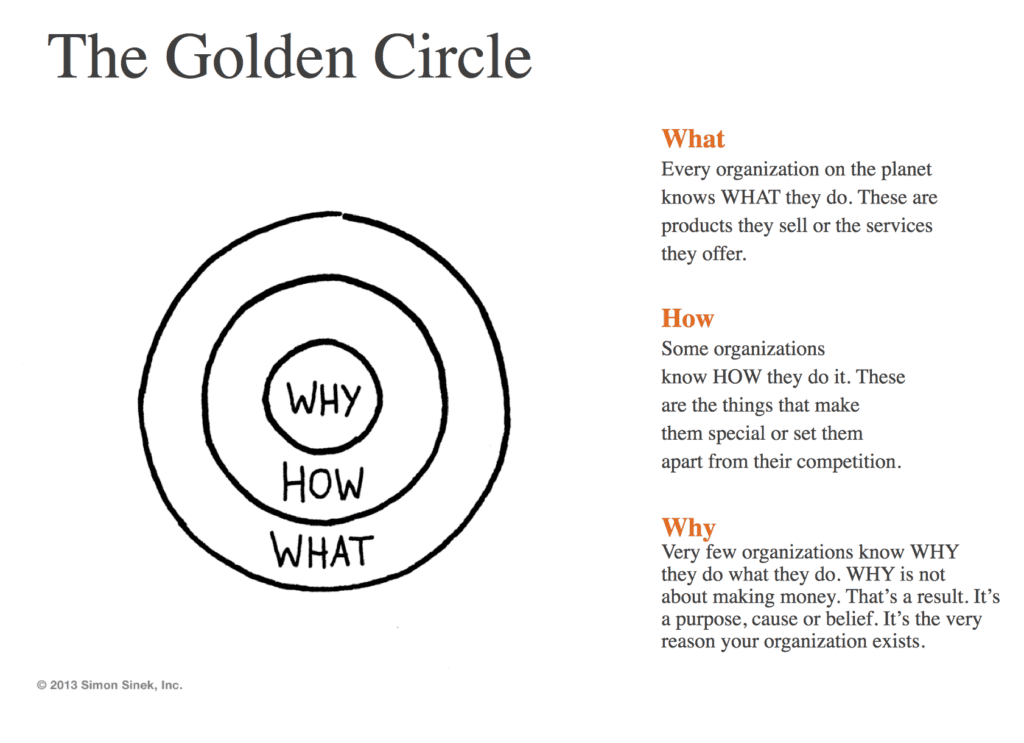
STEP 1: Know your goal
Your core must be your WHY. It is important to define your ultimate goal before anything else. Know that this is the heart of your whole content. Thus, the more defined your goal is, the stronger success awaits for you—along with consistency, of course.
STEP 2: Research about your target market
When creating your every content, you have to specifically design it in a manner that would benefit and focus on your target market. Before planning your HOW, research more about your target audience—their interests, activities, etc. Knowing your demographics would make things a lot smoother.
STEP 3: Plan your schedule
Having your own content calendar allows you to not just stay organized but as well as help trace your posts easily. Moreover, it’s safe to say that planning your schedule keeps you on track, and helps ensure consistency on your end.
Coming up with good content
Now, let’s talk about what you’re really here for: content curation.
4 things that you might want to consider:
What’s hot?
First, it’s always safe to bank on relevance. Research about what’s trending, and try to create content from there. Since they’re very popular, this means that more and more people find them interesting. The thing with trends, however, is that they come and go. With this, not only should you write fast, but you also have to ensure to produce evergreen content. In other words, don’t sacrifice quality, over popularity. Sure, you can always tap on trends, but remember to integrate your core too. In this manner, you get to benefit the best of both worlds, but with caution!
Mind ticker
More often than not, people love to read about odd information. Try to research about odd topics that might pique your target market’s interests. Go for angles that are unusual, but try to avoid fake news and controversies. Know that these come and go, but a tainted reputation is hard to regain. Furthermore, although unusual content doesn’t come easy, it can be very rewarding when done right.
Facts: old or new
Facts are fuel to the brain. They’re very good as conversation starters and even as content hooks. It would be nice to research on fun facts related to your content goals and write about them. Remember to support them well and provide sources!
Hacks
Write tips, provide hacks. With a lot of things on everybody’s plate, learning about a few hacks to make things a lot easier is greatly appreciated by most—if not the whole—community. So, try providing comprehensive and engaging tips and tricks for your audience to enjoy. How to’s and step-by-step processes could work wonders!
Analyzing success
Content creation does not just stop the moment you hit save and publish, but it goes beyond that. It is important to keep track of the numbers in order to weigh things out properly. Effective analysis can do you so much in terms of ensuring engagements, determining your strengths and weaknesses, and improving your traffic.
Final tips
- Make your content engaging. Avoid lengthy posts as much as you can.
- Make it understandable. Avoid highfalutin words, and keep your post direct yet entertaining.
- Don’t let pressure eat you up. Take time to rest and recover. When you feel like your words are failing you, do something else. Then, when you’re ready, get back on to writing. Remember that writing is a very complex activity with endless opportunities. Being out of topic is only but almost impossible. Expand your horizon (think), widen your reach (read), and believe in your capabilities (persevere).
If you need more enlightenment regarding content marketing, click here.
Guide to Content Writing
4 Critical Dos and Don’ts of Web Content Writing and Editing
The world of the web can be very promising. In fact, it is the perfect platform for every brand to easily market, sell, and engage with their audience. However, with its great power should come great responsibility. Anyone who posts anything online are held accountable for their every action. And as a content marketer, you better use your influence right.
How?
Check out these critical dos and don’ts that you must remember:
Don’t
- Be boring
- Beat around the bush
- Plagiarize
- Produce content without proofreading
Do
- Be clear
- Avoid unnecessary points
- Experiment with different content ideas
- Research well
Read the full article here: https://expresswriters.com/dos-and-donts-of-content-writing/
Page Title Writing Best Practices
Google’s New Page Title Writing Best Practices
Google revised its recommended practices for writing page titles, including avoiding substituting your titles in search results.
In August, Google altered how page titles are created in search results.
Google has released an upgrade that would replace some page names in SERPs with more “readable and accessible,” affecting less than 20% of page titles. Though it’s feasible that number will drop even further if websites begin to implement Google’s new recommendations.
Google’s best practices for creating titles are as follows:
- Ensure that each page on your site has its unique title in the <title> element.
- Make each page’s title distinctive and avoid using boilerplate content.
- Keep titles short and avoid text that is too long.
- For the main page, use meaningful titles instead of ambiguous words like “Home.”
- Don’t repeat material in titles to stuff them with keywords.
- When it’s acceptable, include the name of your website at the front of your titles. The home page, for example, might be an excellent place to start. It isn’t required on every page.
Read more: https://www.searchenginejournal.com/google-title-links/422926
How to Map Keywords to Your Content
The method of assigning keywords to relevant pages on your website is known as keyword mapping. It’s where your SEO strategy should begin, and it’s what you should do daily to continue to enrich your website with new keywords as time passes.
Here are seven steps for mapping keywords to content:
Step #1. Build a list of your target keywords
Step #2. Group keywords by topic
Step #3. Double-check the search intent on SERPs
Step #4. Sort keyword groups by difficulty
Step #5. Import your keywords
Step #6. Map keywords to pages
Step #7. Optimize your pages for the mapped keywords
What is the purpose of keyword mapping?
Keyword mapping is a must-do for any SEO or website owner since it may help you enhance your content strategy in a variety of ways, including:
- Look for keyword gaps. Your website may fall behind in rankings because your content strategy does not include all necessary keywords. Keyword mapping will assist you in identifying untapped keyword opportunities and directing them to related pages.
- Look for keyword overlap. Using the exact keywords on different pages might lead to duplicate content and rank cannibalism. Keyword mapping will assist you in assigning keywords to specific target sites that do not clash.
- Streamline internal linking. You’ll be able to manage your internal link-building efficiently. Bringing related pages together if your keywords are correctly categorized and mapped to specific web pages.
Read more: https://www.link-assistant.com/news/keyword-map-guide.html
Map Your Keywords to Your Content (Why, What, and How)
Assuming you already started the task on Day 5: Map Your Keywords to Relevant Web Pages — then you would have realized that 30 minutes is not enough. Depending on the number of keywords you have, this might take more time than what we allotted.
Nevertheless, make it a point to complete the mapping of your top keywords (at least) to relevant pages.
At this point, all you need to do is to continue what you have started on day 5 using your favorite tool. We use both the SEOPowerSuite (Rank Tracker) and the SEOPowerSuite (WebSite Auditor) to map out our keywords to relevant pages.
Further reading: SEO How-To: Mapping Keywords to Content
SEO for Content: 11 Optimization Tips for Beginners
Great content on your website or blog is essential if you want to be seen by potential customers, but optimizing the content for search engines can make a difference in boosting rankings. Here are some quick tips that can help you create SEO-friendly content.
Are you looking forward to improving your search engine ranking with your content? Then, this guide is for you. You will learn the essential tips for optimizing your content to improve your online presence.
What is SEO
Before learning about optimization tips, let us first define SEO. Search engine optimization, or SEO, is the strategy to gain traffic to your online presence. Your virtual presence could mean your business website, blog, app, and more. SEO is optimizing or making your site more accessible for search engines to find, crawl, and index in the search engine results page or SERP.
What is SEO for content?

You can put any content on your website or blog, but it does not mean it will always be visible on the SERPs. If not optimized, search engines may find it challenging to find your content and put it out for online users looking for what you are offering. Therefore, it is crucial to consider SEO every time you create and use content for your online presence and marketing strategies. Remember, even if you have the best quality content online, people will never see it if it is not optimized. People will never know it exists.
How to optimize content for SEO
Optimizing your content entails using different strategies for SERPs to notice and rank your content. Here are some tips you need to consider:
1. Make quality content
First, your content should be of good quality to build a name with your users and with Google. Therefore, you need to provide engaging content, essential to your audience, updated, substantial, and free from grammatical errors.
A well-organized and easy-to-read post is also a mark of good content. Nobody wants to read lengthy and unorganized posts. Be sure to break down your post into smaller paragraphs and use appropriate heading tags.
With valuable, relevant, and professionally written content, you can get your audience to read and trust your site. Better yet, your readers may share your content with others through social media, email, or blog posts.
2. Write for your audience
Remember, your audience should be the center of your content creation because they are the ones you want to attract. So, before creating content, find out first what your target users want to know. One way to do this is by doing keyword research. Then, you can create content based on those search trends. Google Search Console and other keyword research tools can help you with search queries.
3. Use relevant keywords in your content
Once you have your keywords, use them throughout your content to help search engines locate them. This will make your content searchable in SERPs. Here are some tips to remember when using keywords:
- Make sure your focus keyword phrase appears in your article title, the first paragraph of your post, in at least one of your sub-headings, in your SEO title, in the meta description, in your permalink or slug, and in at least one of your image’s alt tags;
- Use keywords as naturally as possible without sacrificing the quality of your content;
- Avoid keyword stuffing or using your keyword phrase too many times in your content;
- Use keyword variations and a good mix of keyphrases since your audience may vary according to search styles;
- Try to focus on long-tail keywords and avoid overly common keywords, which are more difficult to compete with in SERP ranking.
4. Make an effective headline
Titles are sometimes the only thing users need to decide whether they should read your post. So, if you want to engage readers, be sure to create engaging, straight-to-the-point, clear, and keyword-rich headlines. Do the same for your meta description since users can also see them in the search results.
5. Strategically place links
Another way to optimize your content for search engines is by strategically placing internal and external hyperlinks. Internal links are helpful for directing readers to more related content, while external links give credibility to your source material and demonstrate knowledge about the topic. Additionally, when readers click on these outbound links, it signals to search engines that you are providing helpful facts and figures beyond the scope of your article.
Use meaningful anchor texts
An anchor or link text is the clickable text in a link. It is usually underlined and often appears to have a different font color than the rest of your content. The link can either be (1) internal, meaning they lead to another page in your site, or (2) external, which directs users to other sites.
Why do you need to have a good anchor text in SEO?
A good anchor text describes what your users can expect about the page you are linking to. It gives them an idea of what the page is about. Thus, a meaningful anchor text can help increase the chance of readers clicking on it. In addition, search engines can easily find out what the page you are pointing to is all about.
6. Optimize your title tag, meta description, and URL
Your post’s title tag, meta description, and URL (permalink) are what users see on the results page. These are crucial factors that determine whether they will click on your post.

Here are tips on how you can optimize them:
Title tag
The title tag is the headline users can click on for each search result. As I have already mentioned in tip # 5 above, it is very important to make an effective headline as it is one of the factors that can convince people to go ahead and click on your post. Apart from this, search engines also use your title tag to understand what your page is all about.
Optimizing your title tag involves the following:
- Keep your headline under 60 characters;
- Include your focus keyword in the title tag, but don’t attempt to put all your keywords in it;
- Make sure your title describes what your post is really all about.
Meta description
The meta description, right below your title tag, is a text snippet that gives an overview of your post or page. A good meta description, just like an effective title tag, can help convince users to click on your link. You will increase your click-through rate (CTR) if many users click on your page. CTR is a good determining factor for Google to increase its SERP ranking.
To optimize your meta description:
- Be sure you provide a short but relevant overview of your page or post.
- Do not go over 160 characters.
- Include important keywords in it. These would be highlighted on the results page of your users if they typed in your keywords.
URL
The URL or permalink is the web address that tells the location of your web page. Like the title tag, your URL can give users an idea of what the page is about. The important thing to remember about URLs is to keep them accurate, simple, and straightforward so they would be easy for users and search engines to understand. Be sure to avoid lengthy URLs that users may think of as suspicious.
7. Utilize structured data for search engines
Structured data (also known as schema markup or structured markup) adds extra information to your web content that search engines can understand. By using structured data, you can provide search engine bots with in-depth information about your website and its content. You can also add extra features to enhance the appearance of SERPs, such as icons or visuals, which can help click-through rates. Structured data takes some technical programming skills, but if implemented correctly, it can be an effective way to increase the visibility of your content.
8. Add images or videos to your post
Make your post interesting and engaging by adding visuals. Many people can also relate better when you integrate visuals with text content. You can insert images, add infographics, or embed a video to your posts. If you have a YouTube channel, you can promote your video through your blog. You can also promote your blog post through your YouTube channel. Images on your blog may also be “pinned” by your readers. All these make an additional opportunity to promote and increase your website traffic.
9. Manage the ads on your pages
Inserting ads is a great way to earn on your website; however, poorly placed ads can negatively affect user experience. They can affect the flow and readability of your content. Too many advertisements can also add to the clutter on your page, which may turn off visitors.
10. Promote content on social media channels
Social media channels can significantly help you widen your reach when we speak of promoting and increasing website traffic. You can create posts on these channels with links to your site for every new article you publish. If people find your post interesting, they might share it with their network of friends giving you more exposure.
Another way to promote your content using social media is to embed share buttons on your blog posts. This will make it easier for your readers to share your content on different social media channels and email.
11. Monitor your page activities
One way to know if your page is well-optimized is when you start seeing improvements in your site’s activities. You may use Google Analytics to help you see if your page views have increased, if people spend more minutes on your page, if users share, like, or comment on your page, and more. Soon, you may start seeing your link on the first few pages of the search results.

7 Essential SEO Writing Tools for Content Marketers
If you want to write effective content for search engine optimization, these 7 essential tools will give you an edge over the competition. Find out more!
Writing SEO content doesn’t have to be difficult or time-consuming, thanks to the wide variety of tools available for writers. From researching keywords to spotting plagiarism and analyzing readability, these seven essential tools will give you an edge in writing effective search-engine-optimized content.
1. Ubersuggest
Ubersuggest is a tool that helps content marketers improve their search engine optimization (SEO) efforts. It provides various features that can be used to research keywords, analyze competition, and identify opportunities for improving visibility in search engine results pages (SERPs). Some of the key features of Ubersuggest include keyword research, content ideas, backlink analysis, and site audit. It also provides a feature to check the SEO score of any website. Additionally, it provides actionable insights and suggestions for improving the SEO of a website or specific pages. Overall, Ubersuggest is a valuable tool for content marketers looking to improve their SEO and increase visibility in search results.
2. RankMath
RankMath is a powerful SEO plugin for WordPress that helps content marketers optimize their websites and improve their search engine rankings. It provides various features that can be used to research keywords, analyze competition, and identify opportunities for improving visibility in search engine results pages (SERPs). Some of the key features of RankMath include the following:
- Advanced on-page optimization: RankMath allows you to easily optimize your website’s meta tags, titles, and descriptions for better visibility in search results.
- Built-in schema markup: It allows you to add rich snippets, which can help your website stand out in search results.
- Sitemap generation: It automatically generates an XML sitemap for your website, making it easier for search engines to index your pages.
- Site audit: It allows you to find and fix any technical SEO issues on your website, such as broken links, missing images, and more.
- Search console integration: It allows you to connect your website to Google Search Console, giving you valuable insights into how your website performs in search results.
- Advanced analytics: It provides detailed analytics and reports on your website’s performance in search results, making tracking your progress and measuring your success easier.
In conclusion, RankMath is a comprehensive and user-friendly SEO plugin that can help content marketers improve their website’s visibility in search results. It’s easy to use and provides a wide range of features that can help you optimize your website for SEO and improve your search engine rankings.
3. SEMrush
Search engine optimization requires a thorough understanding of the most effective keywords to use. That’s where SEMrush comes in – it’s an incredibly powerful research tool that allows content marketers to easily understand their target audience and conduct keyword research with ease. You can also see competitor metrics, including their keyword strategies, backlinks, and ranking data, to give you a better idea of how your competitors perform.
4. Google Search Console
It’s a free SEO tool offered by Google that very few seem to take advantage of. It allows you to monitor your website’s rankings, impressions, and clicks in search results to track the health of your keywords and overall website performance, diagnoses issues with the website pages, such as issues with the indexing of pages or their visibility in search engine results, and much more. All in all, this is a must-have tool for content marketers looking to optimize their content for better visibility within Google’s search algorithm.
5. Yoast SEO
Yoast SEO is the most popular WordPress plugin for content optimization. While it’s not perfect, it’s still a great tool for quickly getting basic on-page optimization. It does a decent job of helping you optimize your titles, meta descriptions, keywords, and full content for better rankings. Yoast also offers a premium version with more advanced features, such as internal linking analysis and redirect manager – making it an ideal choice for larger websites with comprehensive requirements.
6. BuzzSumo
uzzSumo is a great tool to analyze what content performs best in your industry. It helps you identify successful content topics, view the performance of competitors’ content, and gain insights into what strategies are working the best – all in one place. With BuzzSumo, you can get an idea of how well certain types of topics do across different platforms so that you can write content that resonates with users and appeals to search engines.
7. Moz Pro
Moz Pro is a comprehensive suite of tools designed to help marketers improve their search rankings. With Moz Pro, you can monitor rankings, research keywords, audit your website’s technical SEO performance and link profile, and more. The software also provides real-time keyword suggestions and insights into what types of content do well in your industry, making it an invaluable tool for content marketers looking to get ahead in the SEO game.
More readings on SEO content:
Best readability tools to help improve SEO content
Some of these tools include the following:
- Microsoft Word Editor
- Readable Readability Tools
- WebFX Readability Test
- Datayze Readability Analyzer
- Hemingway App
- Grammarly Online Writing Assistant
- ProWritingAid Writing Assistant
- LanguageTool Writing Assistant
- Ginger Writing Assistant
- Yoast SEO Readability Analysis
Source: https://www.searchenginejournal.com/readability-checkers/460577/
Steps to level up your content strategy and succeed in SEO
- Build a solid foundation by understanding your products, services, customers, and audience’s search behavior.
- Perform content analysis.
- Create a content strategy plan and calendar.
- Evaluate your performance.
- Prioritize creating content that will maximize your investments.
Source: https://www.searchenginejournal.com/level-up-content-strategy-recap/462760/
Google answers whether or not adding content every day can increase search rankings
2022 September 12
Google responds by saying, “No. Posting daily or at any specific frequency, for that matter, doesn’t help with ranking better in Google search results. However, the more pages you have in the Google index, the more your content may show up in search results.”
Source: https://www.searchenginejournal.com/does-adding-content-daily-increase-rankings/464126/
More to Ponder
Ranking your content in SERPs may take time. There are no shortcuts or cheat sheets. What you need is quality, relevant, and timely content that is optimized. With proper SEO for content, you are on your way to improving your online presence and SERP ranking.
If you think SEO is challenging for you as a beginner, you may consider hiring an SEO professional. An SEO specialist can help you get things done and save you a lot of time and other resources.
To learn more SEO tips, notes, and updates, please click on this link: SEO: Search Engine Optimization.

Google’s Content Guidelines Links For Bloggers
This content is said to be published a while back (a couple of years ago or more) in the Google Search developer resources.
Note: After seroundtable.com published this post, Google removed the docs for the blogger SEO practices.
Fortunately, a screenshot was taken. See below:
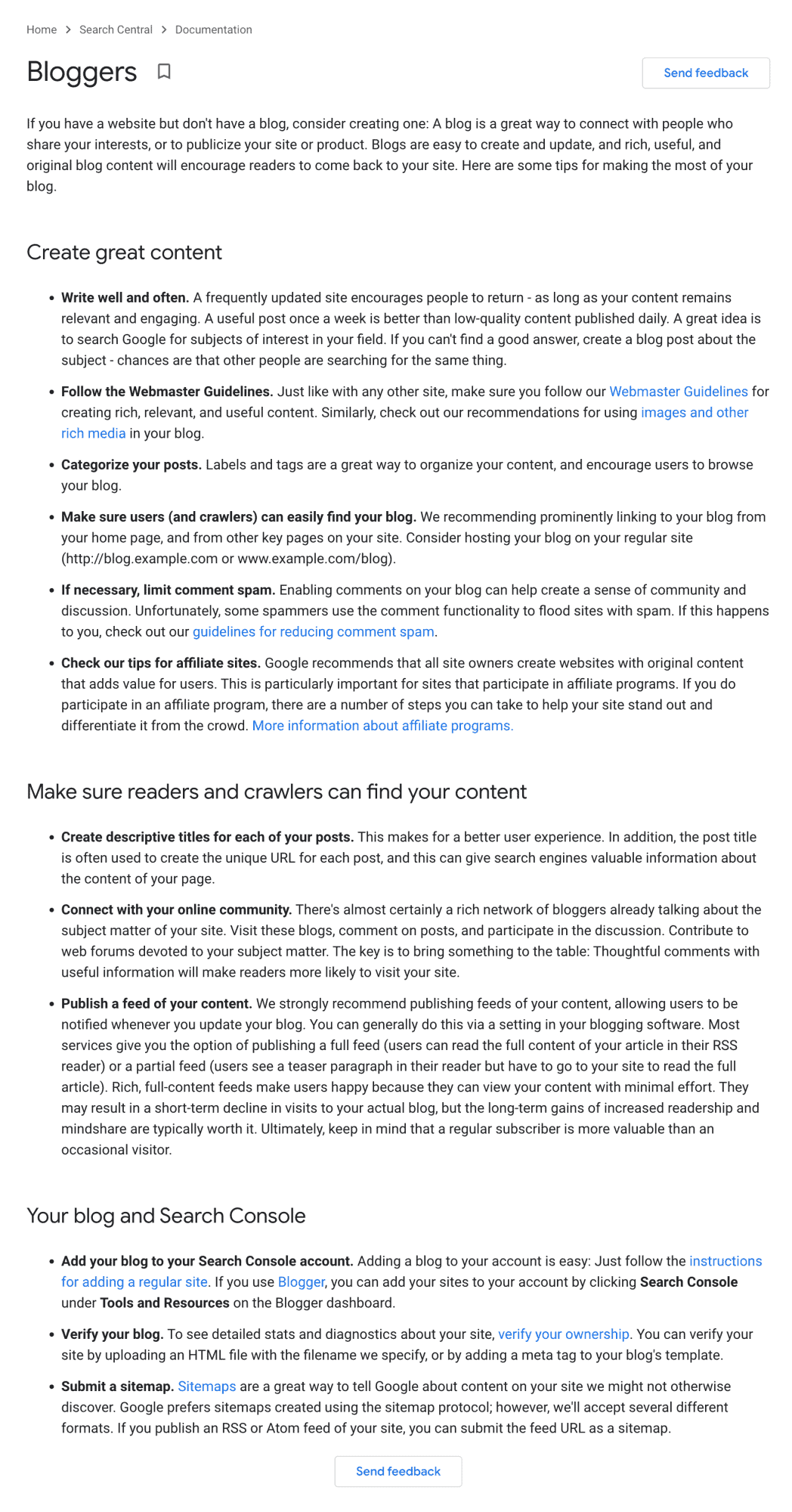
One person commented on seroundtable.com’s post that the said guideline was only removed for the English version and that the guideline for other languages is still available. See the screenshot below:
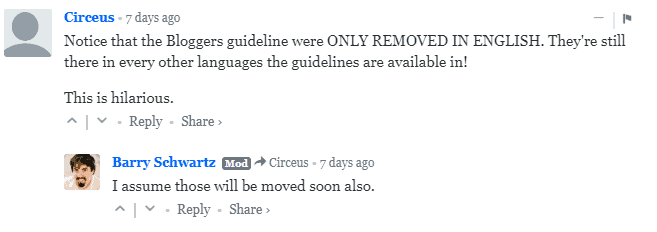
What do we think about it?
Whatever reason Google may have for hiding or removing it, the guideline is very sound. Creating great content and making sure readers and crawlers would find it has been the foundations of SEO. Therefore, let us apply it to whatever we do.
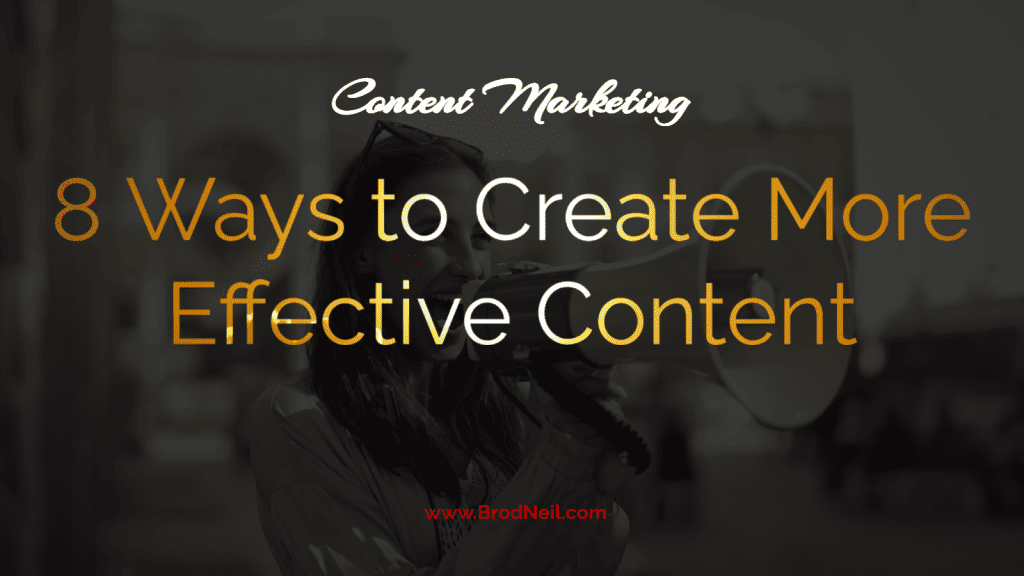
Experts share 8 ways to create more effective content in 2023
These content-writing tips include the following:
- Focus on your target audience.
- Prioritize content quality over SEO optimization.
- Write with search intent in mind and craft informative, relevant, and engaging content for your audience.
- Integrate AI tools wisely.
- Develop your writing skills by practicing regularly.
- Write on topics you are passionate about.
- Have confidence in your writing.
- Connect with other writers and grow your network.
Source: https://www.searchenginejournal.com/content-writing-tips-from-experts/477016/
You can read about content marketing here.
Google research paper says that “documents that attempt to perform SEO tend to be flagged as very low quality”
2023 January 13
The paper further read, “This is intuitive since these texts tend to simply string a series of keywords together and are therefore incoherent.”
Source: https://www.seroundtable.com/google-search-research-paper-negative-on-seo-34688.html
According to Google — unique text, infographics, and videos do not mean that your content is good, accurate, and helpful
2023 January 3
Especially in medicine, it takes much more than these three things to make good content, according to Google’s John Mueller.
Source: https://www.seroundtable.com/google-unique-text-infographics-video-seo-34630.html
Google confirms that you don’t need 200,00 words or 30 articles on your website to be considered authoritative
2022 November 11
John Mueller of Google posts on Twitter that he does not know who made that up, but it’s surely not from Google. In the past years, Google has been stating that word count is not indicative of quality or a ranking factor.
Source: https://www.seroundtable.com/200000-words-google-search-34331.html
Search Engine Land shares a guide on how to do a content audit
2022 November 4
These include:
- Setting clear goals, such as improving SEO and improving engagement;
- Narrowing your focus by choosing a type of content to look into;
- Gathering, organizing, and categorizing URLs;
- Analyzing content based on your goals;
- Assessing your findings and making a plan (keep, remove, update, or rewrite);
- Acting on your plans; and
- Tweaking your content strategy using your results.
Source: https://searchengineland.com/how-to-do-a-content-audit-as-painlessly-as-possible-388695
Google addresses the issue of the percentage that identifies content as duplicate
2022 September 30
The company says that detecting content duplication is not a matter of threshold percentage but comparing the contents’ checksums. The checksum represents content as a series of letters or numbers. Content is a duplicate if the checksum number sequence is similar.
Source: https://www.searchenginejournal.com/google-on-percentage-that-represents-duplicate-content/465885/
Google clarifies that Word Count is not a sign of unhelpful content
2022 September 30
Since 2014, Google has been saying short articles are not low quality, word count is not a ranking factor, it won’t penalize you for short articles, and short articles can rank well.
Source: https://www.seroundtable.com/google-word-count-34092.html
If you are planning to do a content marketing campaign, it might be good to check out this resource. Content marketing is still the most sustainable mid- to long-term strategy to increase your site’s traffic.
More on SEO: Search Engine Optimization.
4 of the Most Effective Content Types to Engage With Your Audience
Getting high levels of engagement and brand awareness is not easy. For starters, there are thousands of other brands that are looking to promote the same content as you. With this, you have to leverage on high-quality content in order to make your brand stand out. Moreover, every person goes through several stages before finally making the decision to purchase from you. It is only but logical for you to be there every step of the way.
Key Takeaways:
- Content means power.
- Over time, buyers have become more and more selective not only with the products that they purchase but with the content that they consume
- Content marketing gets three times more leads than paid search advertising
“People are looking at content they are interested in and they can either run away from you and go to your competitor or feel so related to your brand that they would want to buy from you”
101 Content Ideas to Add to Your Editorial Calendar
Content marketing strategy is an important tool for every successful business. However, it can’t be denied that there really are days when you just need a little more push to kick-start your creativity. And when you do find yourself in one, feel free to save yourself from the hassle and check out these few tips that just might be the solution to your problem.
Key Takeaways:
- Just as success stories are appealing for your audience, know that putting out techniques that don’t work well is also as eye-catching. This element of contradiction to what’s accustomed may actually be a type of content that people crave.
- If there are published blogs from the past that you just love and are truly confident with, there’s a high chance that other brands from the same industry might love them too. Tap on them and let them republish your content for you.
- Keep in mind that when asking for UGC, be specific with your content request, always ask for permission, and always give credit back to the creator.
“You don’t have to tell your story all by yourself”
Read more: https://www.convinceandconvert.com/content-marketing/content-ideas/
Content Syndication: What It Is and How to Get Started
Have you ever noticed that content being posted in one source starts appearing in many other sources, too? Well that is called “content syndication“.
Content syndication can actually help you with your content marketing when done properly. It can help increase your website traffic since the republished content will link to its original source. It can also help increase your email subscriptions and build your brand.
If you want to learn more about content syndication and how you can get started, read Content Syndication: What It Is and How to Get Started.
Effective Ways to Promote Your Content in 2020
What is relevant content without good promotion? You can never overtake your competition or even reach your target audience without effective content promotion strategies.
If you want to learn tips on how you can effectively promote your content through SEO, social media marketing, email marketing, and more, read 101 Effective Ways to Promote Your Content in 2020.
I know that 101 ways can be overwhelming, but you need to remember that promotional strategies are never “one-size-fits-all”. Just learn some tips and pick what fits your business best.
Native Advertising Pros and Cons: Is Sponsored Content for You?
Native advertising allows you to deliver your content in another platform using the latter’s media format, allowing you to advertise your business for a certain fee. These contents may come in the form of Sponsored Posts, Sponsored Content, Recommended for You, and Promoted Stories, among others.
If you wonder if native advertising could be a good strategy for your business, you need to know its benefits and drawbacks.
Key takeaways:
- Native advertising can attract attention.
- Sponsored content increases brand recognition and appeal.
- Advertising can be expensive.
- Native advertising does not help with your SEO.
To learn more, read The Pros and Cons of Native Advertising: Is Sponsored Content for You?
15 Mistakes You May Be Making in Your Content Development
There are many mistakes that people make when they are developing their own content. First, many people and companies in general don’t know their customers well. If you know your customers, you can help tweak your content to meet their specific interests and needs and keep them coming back for more. Many companies also ignore data when in reality, it’s their most useful tool. This data can show you how well specific pieces of content are working, and what areas you probably should ditch. Finally, focus more on high quality content rather than pushing out content every day just for the sake of it. You want your customers to get valuable information from your content each time they read it.
Key Takeaways:
- Many people develop content without understanding customer needs and therefore the content goes unnoticed or unappreciated.
- Make sure you spend the proper amount of time getting data from your customers so that you can tweak your content to fit their needs.
- Instead of rushing to create content, make sure that you are developing and publishing high quality content that will keep customers coming back for more.
“The biggest issue today is fragmenting the brand and wasting huge amounts of resource and time by creating parallel content strategies.”
Read more: https://contentmarketinginstitute.com/2020/07/mistakes-content-development/
Content Marketing Trends for Inbound Marketing
Interactive content
Interactive content is a content marketing trend that has become increasingly popular in recent years, and it is also an effective tactic for inbound marketing. Interactive content refers to any type of content that requires the user to actively engage with it, such as quizzes, assessments, polls, and calculators.
Here are some reasons why interactive content is a great strategy for inbound marketing:
Increases engagement
Interactive content is more engaging than traditional static content. Users are more likely to spend time with interactive content because they are actively participating in the experience. This increased engagement can help keep users on your website longer and reduce bounce rates.
Enhances user experience
To create a more immersive and memorable user experience, interactive content is a good choice. It can help users learn more about your brand or product, and make them feel more invested in the process.
Generates leads
To gather information about potential customers, such as email addresses or other contact details to build your email list and generate leads for future marketing efforts, interactive content can subtly do the job since users are immersed in the content and will surely want to invest more time with your content.
Provides valuable data
Interactive content provides valuable data about user behavior and preferences. This information can be used to improve your marketing strategies, such as creating more targeted content or improving your website’s user experience.
Boosts social media sharing
Users are more likely to share content that they find interesting and engaging, and interactive content provides a unique and fun experience that people want to share with their friends and followers. Interactive content is highly shareable on social media.
Video content
Video content is one of the most effective content marketing trends for inbound marketing. Video content refers to any type of content that is delivered through video, including product demos, explainer videos, vlogs, live streams, and social media stories. Here are some reasons why video content is an effective strategy for inbound marketing:
Increases engagement
Video content is more engaging than static content. It can capture and hold the viewer’s attention for longer periods, making it more likely that they will engage with your content and stay on your website longer.
Builds trust and credibility
Video content can help build trust and credibility with your audience. By showing your product or service in action or providing valuable information through video, you can demonstrate your expertise and establish a relationship of trust with your viewers.
Improves SEO
Video content can help improve your website’s search engine rankings. Search engines like Google favor websites that feature high-quality video content, and video can also help improve on-page SEO factors like bounce rate and time on site.
Increases social media sharing
Video content is highly shareable on social media. Users are more likely to share video content that they find interesting or entertaining, which can help boost your social media presence and increase brand awareness.
Offers versatility
Video content can be used in various ways to support your inbound marketing efforts. It can be used for product demos, explainer videos, customer testimonials, and much more.
Overall, video content is an effective strategy for inbound marketing because it increases engagement, builds trust and credibility, improves SEO, increases social media sharing, and offers versatility. As the popularity of video content continues to grow, it is likely to become an even more important strategy for inbound marketing.
Influencer marketing
Influencer marketing is another content marketing trend that has become increasingly popular in recent years, and it can be an effective strategy for inbound marketing. Influencer marketing refers to the practice of partnering with influential people in your industry or niche to promote your brand or product.
Here are some reasons why influencer marketing is an effective strategy for inbound marketing:
Increases reach and brand awareness
Influencer marketing allows you to tap into the audiences of popular and respected influencers in your industry. This can help increase your brand’s reach and awareness, and introduce your brand to new potential customers.
Builds trust and credibility
Influencers have built a loyal following based on their expertise, personality, and authenticity. When they promote your brand, their followers are more likely to trust and respect their recommendations, which can help build trust and credibility for your brand.
Drives conversions
Influencer marketing can help drive conversions by promoting your product or service to a targeted audience of potential customers. Influencers can create content that showcases your product or service in action and highlight its unique benefits, making it more attractive to their followers.
Improves SEO
Influencer marketing can help improve your website’s search engine rankings by driving traffic to your website and increasing the number of backlinks to your site.
Offers a more personal touch
Influencer marketing allows you to create a more personal connection with your target audience. When influencers promote your brand or product, it can feel like a personal recommendation from a friend or trusted source, which can be more effective than traditional advertising.
Overall, influencer marketing is an effective strategy for inbound marketing because it increases reach and brand awareness, builds trust and credibility, drives conversions, improves SEO, and offers a more personal touch. As the trend towards authenticity and personalization in marketing continues, influencer marketing is likely to become an even more important strategy for inbound marketing.
User-generated content
User-generated content (UGC) is another content marketing trend that has become increasingly popular in recent years and can be an effective strategy for inbound marketing. UGC refers to any content created by users, such as product reviews, social media posts, photos, videos, and blog posts. Here are some reasons why UGC is an effective strategy for inbound marketing:
Increases engagement
UGC can increase engagement with your brand by allowing users to participate in creating content. When users feel like they are part of the content creation process, they are more likely to engage with your brand and share your content.
Builds trust and credibility
UGC can help build trust and credibility with your audience by showcasing real people using and enjoying your products or services. User-generated content is often seen as more authentic and trustworthy than content created by brands.
Offers social proof
UGC can offer social proof of the value of your product or service. When potential customers see others using and enjoying your product, it can make them more likely to make a purchase.
Increases brand awareness
UGC can help increase brand awareness by reaching a wider audience through social media and other online channels. When users share their content with their networks, it can help promote your brand and attract new customers.
Offers cost-effective content
UGC is a cost-effective way to create content for your brand. Rather than creating all of your own content, you can leverage content created by your users to supplement your own content.
Overall, UGC is an effective strategy for inbound marketing because it increases engagement, builds trust and credibility, offers social proof, increases brand awareness, and offers cost-effective content. As social media and other online channels continue to grow, UGC is likely to become an even more important strategy for inbound marketing.
Content Marketing Goals
The main goal of content marketing is to attract and acquire a clearly defined audience, with the objective of driving profitable actions. To fully see the opportunities around you, you first have to understand their essence and think like a content marketer. For starters, you might want to consider using infographics, web pages, podcasts, videos, or even books. You should remember that the ultimate secret to content marketing is to add value.
Key Takeaways:
- Content is good if you’re willing to spend time or money on it. If you want to see examples of great content, look back on what you’ve paid to read, watch, or listen.
- If you’re unsure of how to add value to your content, ask your customers for suggestions of what content they think would be helpful for them now or in the future.
- Most companies are not doing content marketing… yet. And so you have to get on it as soon as possible and be at advantage.
“The return on investment for content marketing can be phenomenal if executed correctly”
Read more: https://www.forbes.com/sites/joshsteimle/2014/09/19/what-is-content-marketing/#5a9c0dca10b9
4 Content Marketing Mistakes to Avoid (And What to Do Instead)
One can’t deny how content marketing is actually one of the most effective, if not the best, strategies available today. But, with this in mind, many brands are also looking into engaging in one, turning it into a highly congested space. What’s more critical is that there are a number of mistakes done by content marketers, slimming down the odds of generating leads.
Firstly, one of the biggest mistakes done by marketers is focusing too much on growing the business instead of penetrating traffic. Secondly, it is failing to experiment on other channels like videos, infographics, etc. Thirdly, it is not creating evergreen content, or those that would still be relevant 5 years later. Lastly, not having enough (or any) CTAs.
Key Takeaways:
- Focus on understanding what content your customer wants
- Turn your current content into multiple formats to appeal to a wider audience
- Research on evergreen topics rather than focusing too much on viral content
“What common content-marketing mistakes have you made?”
Read the full article here” https://neilpatel.com/blog/4-content-marketing-mistakes-avoid-instead/
How would you like to use Google Sheets functions to create an SEO content plan?
This is a guide on how to use Google Sheets functions to create an SEO content plan. It explains how to use various functions to prioritize content creation, turn keywords into URLs, find the oldest content, and clean up spreadsheets. The goal is to help optimize content for better organic rankings and increased website traffic. The article is written by Roslyn Ayers for Search Engine Land and provides related stories and information about the author.
Source: https://searchengineland.com/create-seo-content-plan-google-sheets-functions-432158
The three core pillars of content marketing strategy
Communication
The communication pillar focuses on coordinating content to acquire, keep, and grow customers.
Experiences
The experiences pillar emphasizes treating content as valuable assets for audiences.
Operations
The operations pillar is necessary to manage content creation, distribution, and measurement effectively.
Source: https://www.searchenginejournal.com/the-three-pillars-content-marketing-strategy/495909/
Best practices for content marketing in 2023
Follow these strategies to ensure you continue driving traffic to your website:
- Ensure your content matches what people are actually searching for.
- Use the hub and spoke content marketing model to build authority and increase organic traffic, keyword rankings, and conversions.
- Consider result types and what content people consume based on what appears on the first page of the results page.
- Assess your content for ROI.
- Don’t rely on AI to write your entire content.
- Do a content audit and re-optimize content that is outdated or underperforming.
- Break down silos and emphasize communications, education, and organization to ensure you publish your content effectively.
Source: https://www.searchenginejournal.com/7-content-marketing-best-practices-in-2023/477344/
7 Signs You Need to Fire Your Content Marketing Agency
2022 December 2
It takes time to see the results of content marketing efforts. However, these signs tell you it’s time to say goodbye to your content marketing agency:
- You don’t begin to see results in a few months, and the agency does not set clear goals in the first place.
- The agency keeps on making mistakes in your content, even after corrections.
- You are not satisfied with the quality of the content they have been making.
- The agency does not communicate well with you, leaving you feeling unsure and unsatisfied.
- They continually miss deadlines and don’t adhere to the content schedule.
- The content marketing agency does not treat you like a partner, and you’re not feeling the teamwork.
- You think they are using spammy techniques to get fast, unreliable results.
Source: https://searchengineland.com/fire-content-marketing-agency-389406
Inbound Marketing Isn’t Enough: 7 Content Marketing Goals
there is so much on the internet about how traditional marketing is something that is dead, but this isn’t true. Marketing in the traditional sense isn’t done the same way that it used to be but it is still used and can still be effective. Content marketing is where you create the right kind of content that is both unique and interesting to the people that are going to be reading it, you will want them to associate your content with your brand.
Key Takeaways:
- There are too many articles published that don’t know anything about content marketing.
- It is the practice of putting out content that is going to be engaging for your audience.
- There are a lot of stories out there that say traditional marketing doesn’t work anymore, but it still does.
“Content marketing must include strategic planning, content creation, distribution, and metrics for multiple stages of the buying cycle to multiple customer personas.”
Read more: https://contentmarketinginstitute.com/2011/11/content-marketing-inbound-marketing/
Using content marketing to engage audiences: six examples
Content marketing is about drawing people close to your sphere of influence and then turning them into engaged audiences. Additionally, good marketing generates interested visitors to become shoppers, and then over time, transforms them into advocates of the brand.
Key Takeaways:
- Arrow Electronics has a team designed to create audiences through webinars, email newsletters, and smart use of data.
- Symantec evolved its content approach from a campaign-focused demand gen team to a team focused on audience building and creating content for marketing.
- Monster.com created a career and advice center and spent 18 months optimizing SEO, resulting in an impressive four million job searches, a 65 percent conversion rate, and 48,000 new members.
“An engaged, addressable database is one of the most valuable assets any company can have”
Read more: https://www.chiefmarketer.com/using-content-marketing-to-engage-audiences-six-examples/
Content Marketing Best Practices
Content marketing serves a purpose greater than promotion which is to achieve an engaged audience. It is important to note that a small but well-targeted audience is more effective than a large but unengaged audience. Three common goals shared by content marketers are: to increase website traffic, produce higher quality content, and to become better storytellers.
Key Takeaways:
- Identify niches within content verticals that your target consumers would follow
- Work with influencers as a springboard to score mentions across multiple digital channels
- Be consistent
“Focus on a contextual fit over a numerical fit”
Read more: https://www.grouphigh.com/content-marketing/
The One Big Thing Some of the Best Content Marketers Forget
Content is the focal point of content marketing, but it is not the only thing marketers should concentrate on. The main goal is to reach as many as potential customers possible, regardless of the industry or the size of your business. However, many marketers forget one critical part of their initiative and that is actively promote the content once it’s created. Don’t neglect optimization for search engines and promote your content on as many platforms as you can. Only out of this quantity can you achieve noticeable and measurable results.
Key Takeaways:
- Many of us have a preference for a certain social network. It may be Facebook, so your blog post is published and also posted to Facebook. They think they are done. It’s publish and it’s tweeted-once.
- If you have a blog post in the production line there is an important element to complete before hitting “publish”. It’s called “optimizing for search engines”
- There is one thing to keep in mind with Twitter. It isn’t an inbox but a stream. So tweet your post several times on the first day. If it is evergreen content then it can be tweeted repeatedly.
“What do I mean by hustle? It means pushing, prodding and publishing to as many digital channels as time and resources allow. it means optimizing for search engines, emailing your grandma and making all your social media networks sing.”
Read more: https://www.jeffbullas.com/the-one-big-thing-some-of-the-best-content-marketers-forget/
The Goal of Content Marketing
Understanding and creating the right content marketing goals
Marketing goals are usually mistaken as outcomes. Goals such as brand awareness, conversion, and customer retention are actually outcomes that we want from our marketing strategies. Instead of the traditional approach, marketing goals should be more user-centric. These include education, inspiration, and entertainment.
Read more: https://ahrefs.com/blog/content-marketing-goals/
Why is content strategy a must for every business?
A content strategy is a process of generating ideas as well as creating, publishing, promoting, and managing your content. Search Engine Journal shares five reasons why content strategy matters most:
- Businesses with successful content have a documented content strategy.
- No content strategy means getting no results.
- A content strategy will align your people, processes, and technology to help achieve your goals.
- A well-laid-out content strategy can help you win buy-in from your bosses and department heads or investors.
- A content strategy will give you a competitive edge.
Source: https://searchengineland.com/why-content-strategy-matters-most-393591
Strategic Content Marketing Essentials
Learn essential steps for effective content marketing strategy.
Read: Why Strategic Content Marketing Matters
Best Content Marketing Tools of 2020
Content marketing nowadays is getting more and more competitive with a sea of relevant information on the Internet. In order to stay ahead of your competition, you need to have a sound marketing strategy that is practicable. This can be made easier and more efficient with content marketing tools, software, and applications.
To help you with your content marketing, here is a helpful read on the best tools you can use to get your message to your audience.
Read: Best content marketing tools of 2020
Content Marketing Analytics: 6 Common How-To Questions
You should remember that content marketing doesn’t stop the moment you post your content and make it available to the public. It is a continuous process that entails a number of follow-ups and assessments. You have to look back on your content and check its engagements. Failing to assess your analytics would only leave you behind.
With insufficient knowledge on the ins and outs of content creation, all your marketing efforts could be pointless.
Below are the common questions that content marketers like you should consider:
- How do we know if content is driving conversions?
- How can we discover content gaps in our strategy?
- How much of our content do people read?
- How do we know the best time and day for us to publish content?
- How can we tell how people are interacting with our content?
- How can we see who is reading our content?
Find out the answers here: https://www.webfx.com/blog/marketing/content-marketing-analytics/
Revolutionize Your Content Strategy with These 13 Expert Hacks!
Discover the secrets to turbocharging your content marketing efforts and attracting a flood of clients. From viral brainstorming to mastering multimedia, these innovative tips are your gateway to skyrocketing engagement and conversions. Uncover the game-changing tactics that can reshape your digital presence today!
Read: 13 Content Marketing Hacks That Will Help You Attract More Clients
Build Audience Connections with Content Marketing
Beyond anything else, content marketing is a tool that, when executed properly, positions your brand as an influencer. It begins with working around and presenting concepts that your customers value most. You should also know that it is more than just writing. There are a variety of channels that your brand can use like videos, ebooks, content portals, infographics, online classes, etc.
Key Takeaways:
- Make content digestible by using visuals
- Focus on engagement, not self-promotion.
- Give high regard to quality
“Whatever you do, don’t try to sell”
Read more: https://www.quicksprout.com/build-audience-connections-with-content-marketing/
Conclusion
This is not the end. 🙂
We will continue to update this post.
Here is a related post on content marketing: Content: Best Practices and Trends.
Sources:
- https://www.smartinsights.com/content-management/measure-content-marketing-roi/
- https://www.koozai.com/tv/quick-vids/how-to-measure-the-success-of-your-content-marketing-campaign/
- https://neilpatel.com/blog/8-google-analytics-features/
- https://contentmarketinginstitute.com/2018/09/content-marketing-effectiveness/

